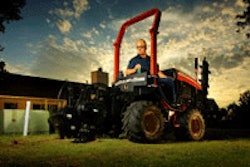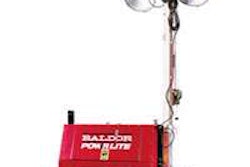Sweeping winds during winter weather can cause dangerous conditions for motorists with greatly reduced visibility due to blowing snow and treacherous drifts if no wind protection is provided on rural sections of roadways.
Addressing these safety concerns, combined with cost savings, environmental stewardship and highway beautification, the Iowa Department of Transportation’s (DOT) living snowfence program has shown amazing results over its more than 40-year development.
These windbreaks may reduce the amount of plowing needed, increasing safety by increasing visibility and keeping snow off the roadway, while also providing wildlife habitat and controlling erosion. Additional safety benefits were recently shown in research done in Wyoming. This testing showed pavement temperatures were higher in areas protected by snowfence when compared to unprotected sites. For states like Iowa that have severe winter weather, the ability to preserve higher pavement temperatures is critical to the effectiveness of salt and other chemicals used to combat the formation of ice on the roadway.
Iowa’s long-standing living snowfence program, both on and off of the right-of-way, consists of planting a combination of trees and shrubs that serve as a windbreak, along with native grasses that help form a snow catch area for blowing and drifting snow. Iowa DOT project fund are used for living snowfence projects on highway rights-of-way.
The rows are five feet apart and the shrubs are three feet apart within the row. The rows are staggered so the plant in one row fills the gap between plants in the adjacent row. With this spacing, Iowa DOT research has shown that the drifts downwind from these plantings will occur up to 10 to 12 times the heights of the shrubs. So by using 10-foot tall shrubs, the snow drifts will form up to 100 to 120 feet downwind.
Using its own
The research also shows that the more open or porous the snowfence, the longer and shallower the drifts. Conversely, the more dense the snowfence, the resultant drifts are shorter and deeper. This information can be used to tailor a design to control the shape and length of the drift.
The Iowa DOT partners with the Iowa Department of Natural Resources (DNR) on many living snowfence projects in highway rights of way. Iowa DOT Chief Landscape Architect Mark Masteller says, “For many projects, the agency is able to use plants from the Iowa DNR’s nursery stock. This reduces costs for the DOT, giving it more miles of snowfence for the dollar, he says. “We see the benefit in increased highway safety and reduced maintenance and the Iowa DNR sees increases in habitat for native songbirds, insects and small mammals,” Masteller says. “It’s a program that works for both agencies.” It’s a program that works for both agencies.”
Working with the Iowa DNR’s nursery stock and planting different plant species during the development process has shown that native plantings work best. In Iowa, the most commonly used plants species are redtwig dogwood, cranberry bush viburnum, arrowwood viburnum, common ninebark, dwarf ninebark and silky dogwood. All of these are fairly dense in their growth habit with many stems or will sprout from the root to offer the best density for snow control.
While the living snowfence program is very successful, there are a few drawbacks. “Issues can come up on more narrow rights-of-way,” Masteller says. “When the snowfence grows to a certain height, it can actually increase drifting problems during major snow events.”
While the snowfence is beneficial to preventing drifting in 70 to 80 percent of routine snowfalls, he says, narrow rights-of-way can fill up quickly during heavier storms. “We have found our maintenance supervisors continue to support these living snowfence projects and see the benefits,” Masteller says. “They simply adjust their maintenance routines accordingly when the snowfall totals exceed a certain point.”
Working with landowners
Off the right-of-way, the Iowa DOT works with landowners through a program from the United State Department of Agriculture’s National Resources Conservation Service (NRCS) that pays landowners to take farmland out of production and plant snowfence to increase highway safety. “Living snowfence programs have been in place for many years on farmsteads, but this was recently adapted for highway use,” says Dennis Burkheimer, Iowa DOT winter operations administrator.
One NRCS project off the right-of-way is near Iowa 57 west of Ackley in north central Iowa. Iowa DOT Highway Maintenance Supervisor Tim Peterson says the agency met with the NRCS and the landowner and came to a 10-year agreement. “It is a bit of a complicated process with so many entities involved, but we were able to get about one-half mile of shrubs and grasses planted along an area known for severe drifting,” Peterson says. “We noticed a benefit the first year. Each year since, that benefit just increases to the point that four years into the project, we have virtually no drifting issues at this location.”
Using native plantings not only helps reduce maintenance costs but also erosion control. Mark Masteller, Iowa DOT chief landscape architect says that the native species have adapted over time to the wide temperature and moisture variations between seasons. “The deep root systems help choke out weeds, minimizing maintenance and also help stabilize the soil along the roadside to reduce erosion,” Masteller says. v
Software vs. Snow Drifts
SnowMan is a user-friendly, desktop software package that works on laptops in the field to help engineers design roadways less likely to be plagued by snow drifts and allow maintenance personnel to more precisely situate snow fences to reduce drifting on existing roadways.
The software is based on a combination of knowledge about the fluid mechanics principles that underlie how snow blows and drifts, and climatological data about seasonal snowfall and wind velocities.
“Wind carries particles of snow along just the way that a river will carry silt and mud,” said lead developed Dr. Stuart Chen, a professor of civil, structural and environmental engineering with the University at Buffalo, N.Y. “Snow fences introduce turbulence that causes the wind to deposit some of the snow particles it has been carrying onto the ground behind the snow fence, leaving the roadway clear.”
But deciding how to configure and place those snow fences is not an exact science, Chen said.
“Snow fences are typically erected according to general knowledge about an area where blowing and drifting occurs,” said Darrell Kaminski, regional design engineer for the Western New York region of the New York State Department of Transportation who helped develop the software. “Fences are typically a standard height and are placed a certain number of feet from a roadway.”
A more precise approach would require maintenance personnel to obtain climate data for an area to determine how much snow and wind that area experiences in a season and then to run a series of calculations to determine the best height and placement for a fence in that location. The big advantage of SnowMan, according to Chen, is that it provides all of these capabilities to the user automatically, whether the goal is to mitigate a specific blowing and drifting problem or to design a new roadway that minimizes blowing and drifting.
“SnowMan allows users to analyze different types and heights of virtual snow fences in a variety of distances from a given roadway so that it is possible to come up with the best solution for a specific site and climate,” said Chen.
“For the first time, it allows us to be precise about where to put snow fences,” said Chen.
“The NYSDOT believes that the SnowMan software will significantly advance the implementation of passive snow-control measures both within New York State and nationwide,” said Joseph F. Doherty, senior civil engineer, operations division, NYSDOT, Albany. “We expect improvements in highway safety, lower winter maintenance costs and reduced impacts on the environment as a result.”
Chen designed the program with former UB graduate student Michael Lamanna, Kaminski and Ronald Tabler of Tabler and Associates, Niwot, Colorado, one of the country’s leading experts in the mitigation of blowing snow. The University is part of the State University of New York. v
For more information on handling drifting snow check out http://www.tablerassociates.comdownloads section.











